Introduction to Slalom
About: This page is part of a series I'm working on to help introduce our kids to ski racing. In this article I'll be covering Slalom.
Article Contants:
- Introduction information for kids and parents just learning about Alpine Ski Racing for the fist time.
- What makes Slalom so challenging
- Components of a Slalom course
- Introduction to the terminology
Introduction
For those just starting out, Slalom (SL), is likely going to be the more challenging of the two technical events, at least at first.
What makes SL so challenging? Several features stack up on top of each other to make SL a demanding day out on the hill. But make no mistake SL is an absolutely brilliant once you've mastered it. What makes SL so challenging? Let's break it down so you can understand how hard your racer has worked once they've mastered Slalom.
First off, you'll notice the proximity between the gates, they're much closer together, approximately half the distance or less compared to Giant Slalom sets, at 7m to 11m through rhythmic corridors and 4m - 6m in combinations. This has the effect of making the gates appeared to be stacked right on top of each other when viewing from the start, especially for a young racer just starting out. When standing at the top of the hill, all of the gates appear to merge into a blur of red and blue, way too close together to navigate. Features such as vertical combinations appear to be set right on top of each other. This is one of the reasons why I believe it's so important for kids to inspect, prior to running a course. The inspection provides them the opportunity to see where they'll be able to make their turns, along with the line they'll take down through the course.
Finally, the biggest challenge slalom throws at ski racers, IMHO, are the conditions. Slalom courses tend to degrade rather quickly, especially for the older kids who ski much more aggressively. As a slalom course degrades, the softer smooth snow gives way to ruts, comprised of harder snow pack that becomes exposed after repeatedly turning on the fastest lines. With softer snow scrapped off, out, and away from around the gates chatter marks get carved into the harder subsurface. Course crews on race days work hard to minimize the changes to the course, but inevitably it’s a losing battle. The ruts work against the skis and thus the racer. As ruts knock racers around, they struggle to retain balance and maintain edge control. The bobbles cost precious speed, as cleanly carved turns are interrupted, thus slowing the racers, and adding time.
At the highest levels of the sport course crews, leading up to race day, will water softer snow down. This has the effect of hardening the upper layers of soft snow, increasing the consistency of the coverage. World Cup racers appreciate the firm conditions. With edges literally as sharp as razors, they prefer their courses resist breaking down. This allows racers at the end of the field have an equitable chance of striking from the back and breaking into the top seed, possibly making the podium for the first time.
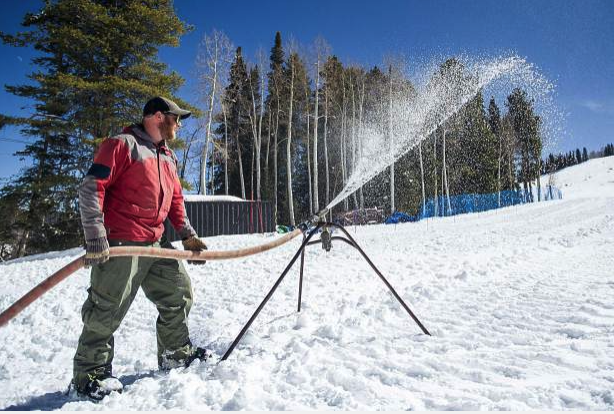
Aspen Snow Maker, Nick Metzger, controls a gun spraying water, preparing the race hill in preparation for the World Cup Finals ski race that was held March 15-19, 2017. The watering process is utilized to create the most consistent and firm course for all the competitors.
Credit: Anna Stonehouse/The Aspen Times | @ https://www.aspentimes.com/news/just-add-water-aspen-mountain-course-prep-for-world-cup-races-includes-watering-copy/
Truly, slalom is an amazing sport, half 400m sprint, half an athletic dance with gravity. SRT coaching staff work diligently with the kids to make sure they're prepared to overcoming the challenges mentioned above. As coaches we keep a close eye on ruts to make sure they don't become too much for the kids to navigate. Keeping the kids safe is the most important aspect of our racing program.
Teaching Technique
Our preferred approach to teaching slalom is to divide up courses into their specific components, with each shorter set aimed at building towards specific objectives. In practical terms, a racer just starting out with SRT will build core skills rapidly through repetition and positive reinforcement. Our step by step, incremental methodology, has been proven to develop great slalom skiers in short time periods. On a typical night of slalom practice kids will experience 4 or more courses in one run. Shorter training course allow for:
- High intensity sprints with the opportunity to build speed.
- A chance to isolate mistakes to one section, learn, reset, and progress.
- Increased one on one time with a coach.
The diagrams below represent, in a similar context, to how we prefer to break down slalom out on the hill. Translation, what you see first in this article is likely going to be a first timer's experience with slalom once we're out skiing. We break slalom down into its individual components, section by section, with some drills thrown in, allowing the racer to gain balance, improve their edge control, and get specific experience such as running combinations.
Section One: Slalom Gates, SL Components, Terms, and Line
First, let's look at how slalom gates are set. Gates are oriented in either a horizontal and vertical formate. (At higher levels diagonal sets are add in, but we avoid those starting out.) The rules state that the tips and boots must break an invisible line projected between the inside gate and outside gate. The turning gate is the gate oriented closest to the next gate down the hill. How racers navigate thru the gates is the same in all events, no matter if its Slalom, Giant Slalom, Super G, or Downhill.
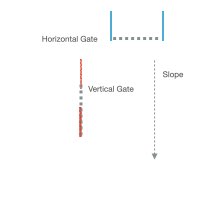
Here's a quick animation I put together for this article to provide you with a look at how to navigate thru a slalom course. It provides a look, albeit sideways, of how to navigate thru horizontal and vertical combination gates, which I will cover a bit later in this article.

Horizontal and Vertically Gates with imaginary lines.
If a ski goes to the inside of a gate its called a straddle and the racer is disqualified if they continue on and finish, without hiking back up above the gate before proceeding. As you can imagine any hiking is going to significantly add time to their run. At the World Cup level races are won or lost by hundredths of a second, so racers will either try and continue on and hope no one noticed, ski off the course, or crash. Straddling can lead to some very dynamic crashes. But don't worry, World Cup racers are made of rubber and bounce when they crash. Just kidding, no one likes to crash, but it happens. They point is to brush it off, review in your mind what happened, and move on.
Note, the only time you'll see an outside gate set is at the start, finish, or in the combinations on the course. Otherwise, it's assumed that the imaginary line the skis have to travel around is perpendicular to the gate and slope of the hill. To do this I'm going to break slalom down into its components for you, then we will see, and practice how they all link up at the end.
The first set you will encounter both in this article and out on the hill, is the most common set, the “Even Rhythm Horizontal Gate” sets.
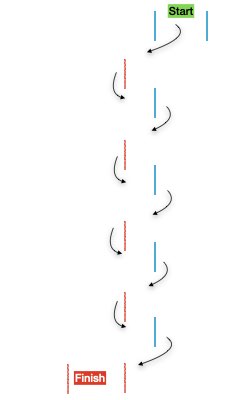
Even Rhythm Course Sets with the approximate line that your skis will travel around the gates.
Even Rhythm sets is where you’ll be starting out your slalom career. You'll see me set a lot of rhythm sections for you all off the top of the hill. These gates are just back and forth, evenly spaced gates designed to set a pace to a course.
Included in the diagram I've laid out for you which side of the gates you go around. The correct side of the gate is called "The Outside" with the other side begin called...wait for it..."The Inside" Very creative lingo isn't it? The black lines with an arrow indicate the approximate line your skis will take around the gate.
Section Two: A Dive into Combination Gates
Next, let’s look at the various vertical combinations that you’ll encounter, they include:
- Hairpins
- Flushes
- Open Gates (aka Banana Turns)
To mix things up a bit and to allow the course setter has at their disposal combination gates, which they use as a means to adapt a course to the characteristics of the trail, typically changes in pitch of slope or direction changes of the trail. Slalom combinations that consist of two vertical gates are called "Hairpins" and three or more are called "Flushes". The final combination, the odd ball, are "Open Gates", but I love to call them by their nickname, "Banana Turns". Banana turns essentially elongate the slalom turn, which breaks the rhythm of the course, and may allow the racer to generate speed or recover their line. Line is a topic I will cover in another article.
Hairpins
The first type of combination we'll look at are "Hairpins", which again consist of two vertically set gates, one red the other blue, or vise versa. Note, in WIJARA, our guidelines state that each course should have two Hairpins for the younger kids. When I set slalom, top to bottom, at Sundown I typically will set one upper hairpin and two in the second half, below the mid way roll on Andrews.
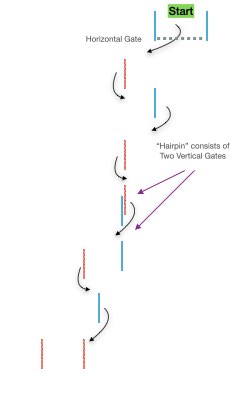
A visual aid, how a slalom set feeds from a horizontal rhythm section into a vertical "Hairpin" combination.
Flushes
The next type of combination we'll look at is the "Flush", which consists of three or more vertically set gates. In WIJARA, for the little kids course we try to keep it easy-peasy with no more that two Flush sections.
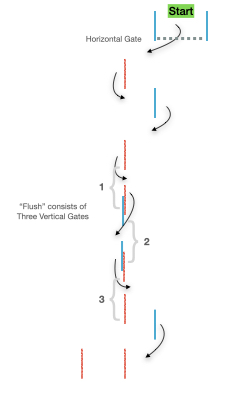
In this diagram, the horizontal slalom set feeds from an even rhythm section into a vertical "Flush" combination which consists of three or more vertical gates.
The Flush sections in slalom courses allow talented slalom skier's to accelerate. With the gain of momentum, the goal is to carry it into the next section. Frequently, course setters will place flushes as the changes pitch from steeps to flat sections. Thus the increase in momentum is vital to the overall run.
Open Gates
The final combination we need to cover are "Open Gates". As I mentioned above, open gates are truly the odd ball in Slalom. Banana turns essentially elongate the slalom turn, which has the effect of breaking the rhythm of the course, they may allow the racer to generate speed or to recover their line from a previous section. Below I've diagramed out how to navigate an open gate.
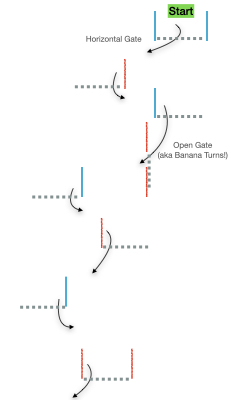
I have to add that Banana Turns on paper do not do them justice, you can see how to navigate thru them, but out on the hill, the effect is much more pronounced. When you see a talented slalom racer navigate banana turns out on the hill, the change in speed is astonishing. When coaching I try and position myself so I can see the kids run thru the sections with Open Gates. How well they're able to manage the change in the radius of the turn speaks volumes to me as to where kids are at in the slalom skiing.
Conclusion
Finally, to wrap up let's have a quick look from the birds-eye perspective of how a slalom course section made-up of fluid rhythm sections and vertical combinations all comes together into a signal section of course.

And for the kids, a bit of animation...

Thank you for reading, stay tuned for more!
Coach Mya
